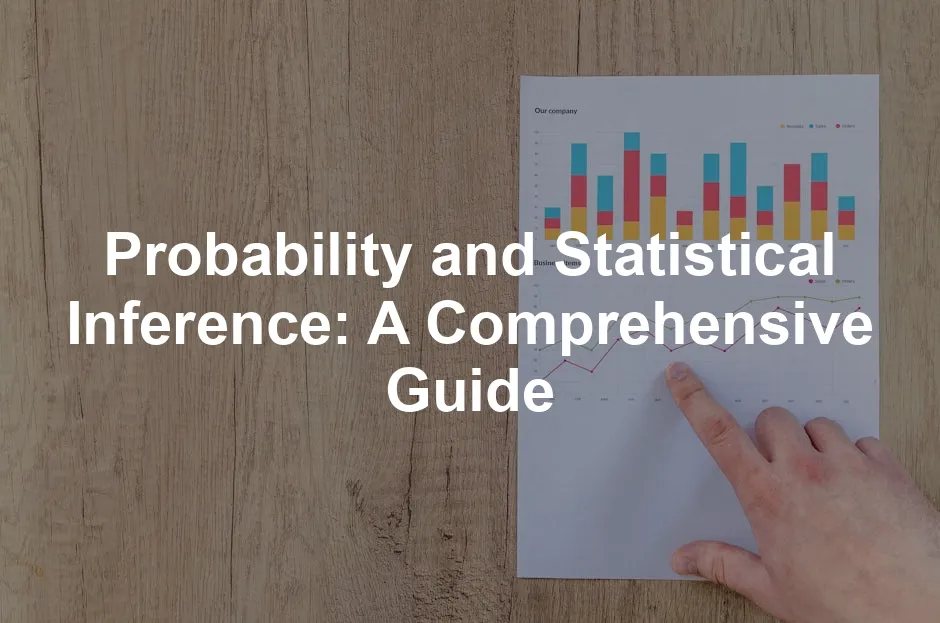Introduction
Probability and statistical inference serve as the backbone of data analysis. These concepts help us make sense of uncertainty, guiding critical decisions across various fields. From predicting weather patterns to assessing risks in business, they embody the art and science of interpreting data.
At its core, probability quantifies uncertainty. It provides a framework for making predictions about future events based on past experiences. Meanwhile, statistical inference allows us to draw conclusions about a population from a sample. It’s like conducting an experiment with a group of friends before deciding what movie to watch with everyone.
If you want to delve deeper into the world of probability, consider picking up Probability: For the Enthusiast by David Williams. It’s a fantastic resource for those who want to explore the intricacies of probability without feeling overwhelmed. You might just find yourself chuckling at the clever examples!
The importance of these topics spans numerous disciplines. Scientists use probability to validate hypotheses. Business analysts rely on statistical inference to forecast sales and market trends. Social scientists apply these concepts to understand human behavior. Without them, we might as well be flipping coins to make decisions!
In this article, readers can expect to learn the foundational concepts of probability and statistical inference. We’ll unravel the basic principles, explore different types of events, and examine common probability distributions. So, if you’ve ever wondered why the odds of winning a lottery are so slim, stick around! By the end, you’ll have a clearer understanding of how probability and statistical inference shape our world.

Understanding Probability
What is Probability?
Probability is a measure of how likely an event is to occur. Think of it as a fancy way to express uncertainty. In statistics, probability assigns a numerical value between 0 and 1 to an event, where 0 means it won’t happen and 1 means it will definitely happen.
Why is probability so crucial? Because it helps us manage uncertainty! For example, weather forecasts use probability to estimate the chance of rain. If the forecast says there’s a 70% chance of rain, it means that, historically, it has rained 70 out of 100 similar days. That’s a pretty solid reason to carry an umbrella!
Now, let’s consider a classic example: gambling. When you roll a six-sided die, the probability of landing on any given number is 1 in 6, or about 16.67%. This straightforward calculation illustrates how we can quantify uncertainty in everyday scenarios.
If you’re curious about how probability influences decision-making, check out Statistics for Dummies by Deborah J. Rumsey. This book is perfect for those who want to grasp the essentials of statistics without the technical jargon. It’s like having a friendly guide to help you through the statistical wilderness!
Probability comes into play in a variety of real-world situations. For instance, medical professionals assess the probability of a patient developing a condition based on risk factors. Similarly, stock market analysts use probability to predict stock fluctuations. The applications are endless!
Understanding probability opens doors to a world where data-driven decisions reign supreme. So, the next time you hear about odds, remember that it’s all about making informed choices amidst uncertainty.

Basic Principles of Probability
Rules of Probability
Probability rules act like the traffic laws of statistics. They help us navigate the often chaotic world of uncertainty! The two fundamental rules are the addition and multiplication rules.
The addition rule tells us how to find the probability of at least one event occurring. If you have two events, A and B, the rule states:
P(A or B) = P(A) + P(B) – P(A and B)
This means you add the probabilities of A and B, but subtract the probability of both A and B happening. Why? Because we don’t want to double-count that overlap!
On the other hand, the multiplication rule is about finding the probability of two events occurring together. For independent events A and B, the rule states:
P(A and B) = P(A) × P(B)
This rule is your go-to when events don’t influence each other. For instance, flipping a coin and rolling a die. The outcome of one doesn’t affect the other.
Types of Events
Events in probability come in different flavors: independent, dependent, and mutually exclusive. Let’s break them down with examples!
Independent Events: These are like your two best friends who don’t influence each other’s choices. The weather doesn’t dictate if your friend will wear blue socks. For example, the flip of a coin and the roll of a die are independent events. The outcome of one doesn’t change the other.
Dependent Events: These events are intertwined, much like a couple who can’t decide where to eat without consulting each other. Imagine drawing cards from a deck without replacement. The outcome of the first draw affects the second. If you draw an Ace, there are now fewer cards to choose from.
Mutually Exclusive Events: Picture a party where you can either have cake or ice cream, but not both at the same time. Two events are mutually exclusive if they cannot occur simultaneously. For example, when flipping a coin, getting heads and tails at the same time is impossible.

Common Probability Distributions
Discrete Distributions
Discrete distributions deal with countable outcomes. Think of them as your favorite board game pieces! Here are three key examples:
1. Binomial Distribution: This distribution applies when you have a fixed number of trials, like flipping a coin multiple times. It’s all about success or failure, with a set probability for each flip.
2. Poisson Distribution: Ever wondered about the number of emails you receive in an hour? The Poisson distribution helps model that! It describes the number of events occurring in a fixed interval of time or space.
3. Geometric Distribution: This one is for when you’re waiting for that first success in repeated independent trials. Think of it as playing darts until you hit the bullseye!

Continuous Distributions
Continuous distributions cover outcomes on a continuum. They’re like the smooth jazz of probability! Here are three common types:
1. Normal Distribution: This is the classic bell curve! Many natural phenomena, like height or test scores, follow a normal distribution. Most values cluster around the mean, with fewer values farther out.
2. Exponential Distribution: This distribution models the time until an event occurs. For instance, how long you wait for the bus. The probability decreases as time passes, making it a handy tool for survival analysis.
3. Uniform Distribution: Here, every outcome has the same probability. It’s like rolling a fair die—each number has an equal chance of appearing. Predictability at its best!

Applications
So, where do these distributions pop up in the real world?
– Binomial Distribution is widely used in quality control processes. It helps assess the number of defective items in a batch.
– Poisson Distribution is essential in fields like telecommunications, where it models call arrivals at a call center.
– Normal Distribution is crucial for standardized testing. It helps determine cut-off scores and analyze performance metrics.
– Exponential Distribution often finds its way into reliability engineering, predicting lifetimes of products.
– Uniform Distribution is useful in randomized algorithms, ensuring fairness in game design and randomized experiments.
By understanding these principles and distributions, you can make informed decisions, whether predicting the weather or assessing risks in business!

Statistical Inference: The Basics
Difference Between Descriptive and Inferential Statistics
Descriptive and inferential statistics are like two sides of the same coin. Descriptive statistics summarize data. They provide a snapshot of the information at hand. Think of it as looking at a movie trailer; you see highlights but not the entire film. For example, if you collect the heights of 50 students, descriptive statistics would tell you the average height, the range, and the standard deviation. It’s all about describing what you have.
On the other hand, inferential statistics take it a step further. They help us make predictions or generalizations about a larger population based on a sample. It’s akin to tasting a spoonful of soup and predicting the flavor of the whole pot. For instance, if you survey 100 people about their favorite ice cream flavor, you can infer what the entire city’s preference might be. Here’s a quick breakdown:
– Descriptive Statistics: Summarizes data (e.g., mean, median, mode).
– Inferential Statistics: Makes predictions about a population (e.g., confidence intervals, hypothesis testing). Learn more about the problems with inferential statistics.
Inferential statistics are essential for making predictions and generalizations about larger populations based on samples. Explore the issues surrounding inferential statistics.
Both types are crucial in the world of data analysis, each serving its unique purpose.

Point Estimation
Concept
Point estimation provides a single value as an estimate of a population parameter. It’s like finding the best guess for the average height of all students based on a small group. This method is significant because it simplifies the complex data into understandable figures.
Methods
1. Maximum Likelihood Estimation (MLE): This method finds the parameter values that maximize the likelihood of the observed data. For example, if you’re trying to estimate the average score of students in a class, MLE helps identify the average that makes your observed scores most probable.
2. Method of Moments: This approach uses sample moments (like the sample mean and variance) to estimate population parameters. If the sample mean is 80, then you might estimate that the population mean is also around 80. It’s a straightforward and intuitive method but might not always provide the most accurate estimates.
Both methods have their strengths and weaknesses. MLE is often preferred for its statistical properties, while the Method of Moments is easier to compute. If you’re looking for a comprehensive guide on statistical concepts, check out Practical Statistics for Data Scientists by Peter Bruce. This book provides a fantastic overview of essential statistics for data science!

Confidence Intervals
What They Are
Confidence intervals provide a range of values, derived from sample data, that likely contains the population parameter. It’s like saying, “I’m 95% sure that the average height of all students is between 160 cm and 170 cm.” The confidence level reflects how sure we are about this range.
Construction
To calculate a confidence interval for means, you typically use the formula:
[ CI = \bar{x} \pm Z \left( \frac{s}{\sqrt{n}} \right) ]
where \(\bar{x}\) is the sample mean, \(Z\) is the Z-score corresponding to the desired confidence level, \(s\) is the sample standard deviation, and \(n\) is the sample size. For proportions, the formula is slightly different but follows a similar structure.
Real-World Use
Confidence intervals are widely applicable. In surveys, they help gauge public opinion, allowing organizations to understand what percentage of the population might support a policy. In experiments, researchers use them to measure the effectiveness of new drugs or treatments. They provide a safety net of assurance that the findings are reliable, making confidence intervals a key tool in the statistician’s toolbox.

Steps in Hypothesis Testing
Hypothesis testing is a systematic procedure used to evaluate claims about a population based on sample data. Here’s a breakdown of the steps involved:
1. Set Hypotheses: Start with two opposing hypotheses. The null hypothesis (H0) usually states that there is no effect or no difference. The alternative hypothesis (H1) suggests that there is an effect or a difference. For example, if you’re testing a new drug, H0 might state that the drug has no effect on patients, while H1 would claim that it does.
2. Select Significance Level: Choose a significance level (alpha), commonly set at 0.05. This threshold determines how strong the evidence must be against H0 before you reject it. If the p-value (the probability of obtaining the observed results) is less than alpha, you can reject H0.
3. Collect Data: Gather data through experiments or surveys. Ensure that the sample is representative of the population for accurate results.
4. Perform the Test: Use appropriate statistical tests (like t-tests or chi-square tests) to analyze the data. This step involves calculating a test statistic, which helps determine how far your sample data deviates from what’s expected under H0.
5. Make Decisions: Based on the calculated p-value, decide whether to reject or fail to reject H0. If the p-value is less than alpha, reject H0, indicating significant evidence for H1. If it’s greater, you fail to reject H0, meaning you don’t have enough evidence to support H1.
6. Interpret Results: Finally, interpret your findings in the context of your research question. Discuss the implications and limitations of your study to provide a comprehensive view of the results.

Types of Errors
Type I and Type II Errors
In hypothesis testing, errors can occur, which are categorized into two types:
– Type I Error: This error happens when you reject H0 when it’s actually true. Imagine a fire alarm going off when there’s no fire—annoying, right? The probability of making a Type I error is denoted by alpha (α). For example, if you conclude that a new teaching method is superior when it isn’t, you’ve committed a Type I error.
– Type II Error: This error occurs when you fail to reject H0 when it’s false. It’s like ignoring a fire alarm when there’s a real fire! The probability of making a Type II error is denoted by beta (β). For instance, if a new medication is effective, but your test fails to detect it, that’s a Type II error.

Power of a Test
The power of a test is the probability that it correctly rejects H0 when it is false. In simpler terms, it measures a test’s ability to detect an effect if there is one. Higher power is better—aim for at least 0.80, meaning you have an 80% chance of detecting an effect if it exists.
To improve the power of a test, consider the following strategies:
1. Increase Sample Size: A larger sample provides more accurate estimates of population parameters, reducing variability and enhancing power.
2. Use a More Sensitive Test: Choose statistical tests that are more capable of detecting differences or effects. For example, paired t-tests are generally more powerful than independent t-tests when applicable.
3. Increase the Significance Level: Raising alpha from 0.05 to 0.10 increases the chances of rejecting H0, but be cautious! This approach raises the risk of Type I errors.

Common Statistical Tests
T-tests
T-tests are widely used to compare means between groups. There are three main types:
1. One-sample t-test: Compares the mean of a single group to a known value. For instance, testing if the average height of students in a class differs from the national average.
2. Independent t-test: Compares the means of two independent groups, like testing if male and female students have different average heights.
3. Paired t-test: Compares means from the same group at different times, like measuring the weight of participants before and after a diet program.

Chi-Square Tests
Chi-square tests assess relationships between categorical variables. Use them when you want to determine if the distribution of a categorical variable differs from what you would expect. For example, you might test whether there’s a significant difference in the preferred type of music among different age groups. The formula calculates the chi-square statistic, helping to evaluate the observed versus expected frequencies.
ANOVA
Analysis of Variance (ANOVA) compares means across three or more groups. This test helps determine if at least one group mean is different from others. For instance, if you want to compare the effectiveness of three different fertilizers on plant growth, ANOVA can tell you if any fertilizer stands out. If the ANOVA test shows significant results, you may follow up with post-hoc tests to find out which specific groups differ.

Bayesian Inference
Overview
Bayesian inference offers a refreshing twist on how we interpret data. Unlike frequentist methods, which rely heavily on the idea of long-run frequencies, Bayesian inference embraces prior beliefs. This approach allows for updating these beliefs as new evidence emerges. Imagine you’re betting on a horse race. If you start with a hunch about a horse’s chances based on its training, Bayesian inference lets you adjust that belief based on how it performs in the lead-up to the race. It’s all about evolving perspectives!

Applications
Bayesian inference finds its home in numerous fields. In healthcare, it helps analyze clinical trial data, allowing researchers to update their hypotheses as new information becomes available. For instance, a study might start with a belief about a drug’s effectiveness, which can shift as new patient data rolls in. In finance, analysts use Bayesian techniques to refine risk assessments based on changing market conditions. Even in tech, companies apply Bayesian inference in algorithm development, enhancing recommendations and predictions in machine learning systems.
Non-parametric Methods
Definition
Non-parametric methods are statistical techniques that don’t assume a specific distribution for the data. They’re like the rebels of the statistical world—free from the constraints of normality! These methods come in handy when dealing with small samples or skewed data. If you’re analyzing survey results with outliers, non-parametric methods could save the day by providing reliable insights without the need for complex assumptions.
Examples of Non-parametric Tests
Two popular non-parametric tests are the Wilcoxon rank-sum test and the Kruskal-Wallis test.
The Wilcoxon rank-sum test compares the ranks of two independent samples. Imagine you’re comparing the satisfaction ratings between two restaurants. Instead of assuming the ratings follow a specific distribution, this test ranks all responses and checks for differences.
On the other hand, the Kruskal-Wallis test extends this idea to three or more groups. Think of it like a food festival where you want to know if different food stalls attract different crowds. This test helps determine if at least one stall is truly more popular than the others. It’s a great way to assess differences without making unwarranted assumptions about the data’s shape.
Computational Inference
Modern Techniques
Modern statistics has embraced computational inference with open arms! Techniques like bootstrapping and Monte Carlo simulations allow statisticians to tackle complex problems with flair. Bootstrapping involves resampling data to estimate the distribution of a statistic. It’s akin to getting a second opinion from your friend about your outfit choices—sometimes, a fresh perspective helps!
Monte Carlo simulations, on the other hand, use random sampling to model the probability of different outcomes. It’s like playing a board game multiple times to see how different moves might pan out. This technique is invaluable for understanding risk and uncertainty in various scenarios.
Importance
The relevance of these computational techniques cannot be overstated! They empower statisticians to answer questions that traditional methods struggle with, especially in the age of big data. By providing more accurate estimates and confidence intervals, computational inference enhances decision-making across sectors, from finance to healthcare. As data continues to grow exponentially, these techniques ensure that we keep pace, making sense of it all with confidence and clarity.
FAQs
Please let us know what you think about our content by leaving a comment down below!
Thank you for reading till here 🙂
All images from Pexels




